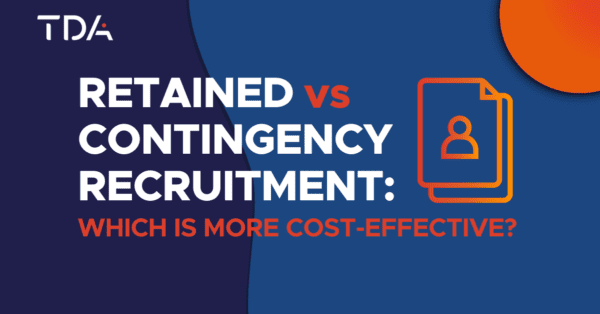In the current highly competitive job market, securing the right talent is crucial for the prosperity of any organization.
The utmost priority for businesses is to hire the most qualified candidates efficiently and cost-effectively. Two commonly utilized recruitment approaches are contingency recruitment and retained recruitment.
This blog post aims to compare these two methods and establish which process is the most cost-effective solution for your hiring needs.
Understanding Retained Recruitment
Retained recruitment establishes a collaborative relationship between the hiring company and a recruitment agency. In this approach, the company pays an initial fee to secure exclusive services from the agency.
Subsequently, the agency’s resources are wholly devoted to identifying the most suitable candidates tailored to the company’s requirements. This method guarantees a concentrated focus on fulfilling the client’s needs and often involves a comprehensive search process.
Pros and Cons of Retained Recruitment
There are many advantages to using retained recruitment. Firstly, the exclusivity of the partnership guarantees that the agency spends a lot of time and effort learning about the company’s culture, values, and hiring standards. This results in a more targeted and comprehensive candidate search. Furthermore, the retained model provides the agency with a higher level of commitment, resulting in greater collaboration and better communication throughout the hiring process.
However, compared to other methods, retained recruitment can be more expensive. The initial fee may appear to be a financial burden, particularly for smaller organizations with limited budgets. Furthermore, the arrangement’s exclusivity may limit the company’s ability to pursue other recruitment options.
Exploring Contingency Recruitment
In contrast to retained recruitment, contingency recruitment allows multiple recruitment agencies to participate competitively for the same job opening. In this model, agencies are compensated only upon successfully placing a candidate. Companies frequently engage with multiple recruitment agencies to enhance their chances of promptly identifying appropriate candidates.
Pros and Cons of Contingency Recruitment
Contingency recruitment provides flexibility and access to a broader range of candidates. By involving multiple agencies, you can source many potential hires simultaneously, which is particularly advantageous when there is an urgent need to fill positions or when the available candidate pool is limited.
However, in comparison to retained recruitment, contingency recruitment may result in a less dedicated and customized approach. Agencies’ emphasis on quantity rather than quality may result in more unsuitable candidates being presented. Furthermore, the lack of exclusivity can affect the level of communication and commitment from participating agencies.
Factors to Consider in Cost-Effectiveness
When assessing the cost-effectiveness of recruitment methods, it is essential to consider several factors. These factors include the company’s specific hiring requirements, the position’s time sensitivity, the current state of the industry and job market, and the availability of qualified candidates.
It is essential to evaluate the overall value and long-term impact of the recruitment method on the organization’s goals and objectives. By considering these factors, a more informed decision can be made regarding the most cost-effective approach to recruitment.
Comparing Costs of Retained and Contingency Recruitment
Although retained recruitment may involve higher initial expenses, it can lead to a more streamlined hiring process and higher-quality hires. The agency’s exclusivity and dedicated resources contribute to a focused search, reducing the time and effort required for candidate screening and interviews.
Conversely, contingency recruitment may have lower upfront costs, but the overall expenses can rise due to the engagement of multiple agencies and extended recruitment timelines.
Assessing the Quality of Hires
The calibre of hires plays a vital role in assessing the cost-effectiveness of recruitment methods. Retained recruitment often delivers higher-quality hires due to the extensive knowledge of the company’s requirements and culture. The personalized approach facilitates a more precise alignment between the candidate and the organization’s needs.
Conversely, contingency recruitment may generate a larger pool of candidates, but the screening process may be less stringent, increasing the risk of mismatches.
Long-Term Relationship Building
Retained recruitment fosters long-term relationships between the hiring company and the recruitment agency. Beyond individual placements, the agency transforms into a trusted ally, developing a deep understanding of the company’s hiring needs. This ongoing relationship improves candidates’ alignment with the company’s culture and future requirements.
Contingency recruitment, on the other hand, limits the potential for fostering such long-term partnerships because it lacks exclusivity.
Industry-Specific Considerations
Different industries have different recruitment needs. Specific industries, such as highly specialized fields or executive-level positions, often benefit more from a customized and comprehensive approach to retained recruitment.
Contingency recruitment may be a more cost-effective option in industries with a larger candidate pool and less specialized positions.
Case Studies
Let’s consider two case studies to demonstrate the cost-effectiveness of retained and contingency recruitment.
Case Study A, a technology start-up with specific needs, opted for retained recruitment. This strategy resulted in hiring highly skilled candidates who fit seamlessly with the company’s culture.
Case Study B, a retail chain with a high turnover rate, used contingent recruitment to quickly fill positions across multiple locations. Because they met the specific needs and objectives of the respective businesses, both approaches were deemed cost-effective.
The Importance of a Tailored Approach
When deciding between retained and contingent recruitment, it is critical to evaluate your organization’s specific needs and align them with the benefits and drawbacks of each method.
Taking a tailored approach ensures that the chosen recruitment method is cost-effective and produces the best results for your organization’s long-term development and success.
Making an Informed Decision
When making an informed decision, consider several factors, including budget constraints, hiring urgency, desired candidate quality, and level of industry specialization. Examine the benefits and drawbacks of both retained and contingent recruitment methods in the context of your specific requirements. Seeking advice from recruitment experts and researching relevant case studies in your industry can provide valuable insights to help you decide.
Conclusion
Retained and contingency recruitment are two distinct approaches to finding the best talent for your company. Each method has its own set of benefits and drawbacks.
However, several factors come into play when determining which approach is more cost-effective, including company size, industry, and hiring requirements.
Understanding the complexities of each method and aligning them with your specific needs allows you to make an informed decision that maximizes cost-effectiveness and allows you to secure the most suitable candidates, thus contributing to your organization’s success.
How TDA Can Help
At TDA we can help supercharge your recruitment strategy and help unlock top-tier talent for your organization, whether it’s retained or contingency recruitment.
Just fill out the form below and someone from our team will be happy to book in a call and discuss your hiring needs.







